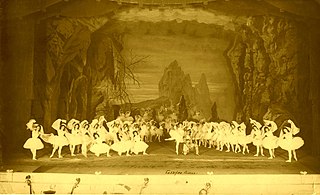Related Research Articles

Swan Lake, Op. 20, is a ballet composed by Russian composer Pyotr Ilyich Tchaikovsky in 1875–76. Despite its initial failure, it is now one of the most popular ballets of all time.

Pierina Legnani was an Italian ballerina considered one of the greatest ballerinas of all time.

Russian ballet is a form of ballet characteristic of or originating from Russia.

Marius Ivanovich Petipa, born Victor Marius Alphonse Petipa, was a French ballet dancer, pedagogue and choreographer. Petipa is one of the most influential ballet masters and choreographers in ballet history.

Mlada is an opera-ballet in four acts, composed between 1889 and 1890 by Nikolai Rimsky-Korsakov, to a libretto by Viktor Krylov that was originally employed for an aborted project of the same name from 1872.

The Saint Petersburg Imperial Bolshoi Kamenny Theatre was a theatre in Saint Petersburg.

La Bayadère is a ballet, originally staged in four acts and seven tableaux by French choreographer Marius Petipa to the music of Ludwig Minkus. The ballet was staged especially for the benefit performance of the Russian Prima ballerina Ekaterina Vazem, who created the principal role of Nikiya. La Bayadère was first presented by the Imperial Ballet at the Imperial Bolshoi Kamenny Theatre in St. Petersburg, Russia, on 4 February [O.S. 23 January] 1877. From the first performance the ballet was universally hailed by contemporary critics as one of the choreographer Petipa's supreme masterpieces, particularly the scene from the ballet known as The Kingdom of the Shades, which became one of the most celebrated pieces in all of classical ballet. By the turn of the 20th century, The Kingdom of the Shades scene was regularly extracted from the full-length work as an independent showpiece, and it has remained so to the present day.

Don Quixote is a ballet in three acts, based on episodes taken from the famous novel Don Quixote de la Mancha by Miguel de Cervantes. It was originally choreographed by Marius Petipa to the music of Ludwig Minkus and first presented by Moscow's Bolshoi Ballet on 26 December [O.S. 14 December] 1869. Petipa and Minkus revised the ballet into a more elaborate and expansive version in five acts and eleven scenes for the Mariinsky Ballet, first presented on 21 November [O.S. 9 November] 1871 at the Imperial Bolshoi Kamenny Theatre of St. Petersburg.
Paquita is a ballet in two acts and three scenes originally choreographed by Joseph Mazilier to music by Édouard Deldevez and Ludwig Minkus. Paul Foucher received royalties as librettist.

Fiametta or Fiammetta, is a ballet in four acts and four scenes, choreographed by Arthur Saint-Léon to music by Ludwig Minkus, first presented by the Ballet of the Moscow Imperial Bolshoi Theatre on November 12–24, 1863 at the Moscow Imperial Bolshoi Theatre, Moscow, Russia, with Anna Sobeshchanskaya as Fiametta.

Arthur Saint-Léon was the Maître de Ballet of St. Petersburg Imperial Ballet from 1859 until 1869 and is famous for creating the choreography of the ballet Coppélia.
Roxana, the Beauty of Montenegro is a fantastic ballet in four acts, with choreography by Marius Petipa and music by Ludwig Minkus. Libretto by Sergei Khudekov and Marius Petipa.
Zoraiya, the Moorish Girl in Spain is a grand ballet in 4 acts/7 scenes, with choreography by Marius Petipa and music by Ludwig Minkus.

Le Diable à quatre is a ballet in two acts and three scenes, with choreography by Joseph Mazilier, music by Adolphe Adam, and libretto by Adolphe de Leuven, first presented by the Ballet of the Académie Royale de Musique on 11 August 1845, with Carlotta Grisi and Lucien Petipa.
The Little Humpbacked Horse, or The Tsar Maiden is a ballet in four acts and eight scenes with apotheosis.

Tchaikovsky Pas de Deux is a ballet choreographed by George Balanchine to a composition by Pyotr Ilyich Tchaikovsky originally intended for act 3 of Swan Lake. With costumes by Barbara Karinska and lighting by Jack Owen Brown, it was first presented by New York City Ballet at the City Center of Music and Drama, New York, on 29 March 1960. Robert Irving conducted the New York City Ballet Orchestra. The dancers were Violette Verdy and Conrad Ludlow.

Le Poisson doré is a "fantastic ballet" in 4 acts/6 scenes with prologue and epilogue. The choreography was by Arthur Saint-Léon, and the music by Ludwig Minkus.

Ludwig Minkus, also known as Léon Fyodorovich Minkus, was a Jewish-Austrian composer of ballet music, a violin virtuoso and teacher.

Galina Olegovna Stepanenko is a Russian ballet teacher. She is a former prima ballerina of the Bolshoi Ballet, and since 2013 has been head of the Bolshoi's ballet troupe.

Evgenia Pavlovna Sokolova was a Russian dancer and educator. She was one of the most famous ballerinas of her period and later became a famous ballet teacher.
References
- ↑ Wortman, Richard (2000). Scenarios of Power: From Alexander II to the abdication of Nicholas II. Princeton University Press. p. 226. ISBN 0-691-02947-4.
- ↑ Letellier, Robert Ignatius (2008). The Ballets of Ludwig Minkus. Cambridge Scholars Publishing.
- ↑ Letellier, Robert Ignatius (2008). The Ballets of Ludwig Minkus. Cambridge Scholars Publishing.
- ↑ Beaumont, Cyril (1937). The Complete Book of Ballets. Putnam, London.
- ↑ Letellier, Robert Ignatius (2008). The Ballets of Ludwig Minkus. Cambridge Scholars Publishing.